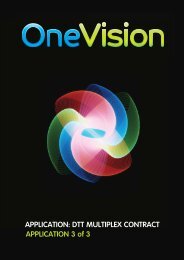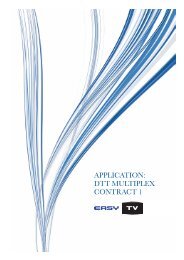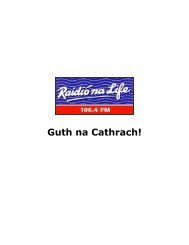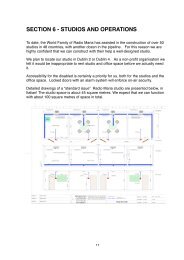Digital Radio for Ireland: Competing Options, Public Expectations - BCI
Digital Radio for Ireland: Competing Options, Public Expectations - BCI
Digital Radio for Ireland: Competing Options, Public Expectations - BCI
Create successful ePaper yourself
Turn your PDF publications into a flip-book with our unique Google optimized e-Paper software.
adio began DAB transmissions two or three years after the public broadcaster, DR, and is beginning to <br />
develop a substantial presence on the national digital network. The comparable size and configuration <br />
of the market, there<strong>for</strong>e, make more detailed study of such cases vital <strong>for</strong> further strategic planning in <br />
<strong>Ireland</strong>. <br />
5.2.3 The consumer proposition <br />
In the current very difficult economic environment, the prospects <strong>for</strong> developing a viable consumer <br />
market base <strong>for</strong> digital radio remain challenging. There will be very limited appetite among consumers <br />
<strong>for</strong> increased charges, taxes or licence fee increases to fund development of digital radio. Likewise, as <br />
demonstrated both in the RTÉ audience research and in our focus groups, radio receivers are not at <br />
present a strong consumer electronics proposition. The experience to date has shown that there is <br />
little awareness or understanding among the public of what digital radio is, why it may be necessary or <br />
what it could potentially offer. Indeed, while anecdotal, experiences of consumers reported in this <br />
research illustrate examples of where consumers have been treated poorly and where retailers also <br />
have a very limited understanding of digital radio. <br />
5.2.4 The community sector <br />
A further challenge <strong>for</strong> digital radio in <strong>Ireland</strong> is to ensure its inclusiveness, and in particular, to ensure <br />
that <strong>Ireland</strong>’s important community and not <strong>for</strong> profit sector are adequately represented in digital <br />
planning. As discussed in this report, there are contrary views on how this might be achieved, ranging <br />
from re‐planning of DAB+ frequencies and/or FM, to better ultilisation of the internet <strong>for</strong> community <br />
broadcasting. At present, it is clear that the community sector does not have the in<strong>for</strong>mation it needs <br />
to make an adequate assessment of the options available. Again, the lack of suitable international <br />
examples has hindered further discussion and debate of the area. The digital future of community <br />
radio requires attention and research and will demand a specific focus from the BAI as it moves <br />
towards policy and implementation. <br />
<br />
5.3 Advantages and Opportunities <br />
5.3.1 Strength of radio in <strong>Ireland</strong> <br />
One of the main advantages <strong>for</strong> the Irish radio sector is its current strength and high level of public <br />
support and loyalty. As we quoted in the Introduction, about 86% of the population listens to some <br />
radio whether community, local or national and Irish people spend an average of 4 hours a day with <br />
radio, one of the highest listenership rates in the world. Commercial national, regional and local radio, <br />
while still relatively young in <strong>Ireland</strong>, has carved out a stable market <strong>for</strong> itself and there is broad <br />
diversity of public, private and not <strong>for</strong> profit radio services across the Irish media landscape. <br />
5.3.2 Late adoption of digital <br />
<strong>Ireland</strong>’s relatively late entry into digital broadcasting, while a challenge in terms of the catch‐up <br />
required overall, may also be considered an advantage and creates opportunities that may not have <br />
been available to previous entrants. As in many cases of technology adoption, relatively late adopters <br />
have the advantage of being able to learn from the experiences and the mistakes in other markets. In <br />
the United Kingdom, <strong>for</strong> instance, the early adoption and support <strong>for</strong> DAB has created one of the <br />
success stories <strong>for</strong> the DAB plat<strong>for</strong>m but also creates a problem <strong>for</strong> migration to DAB+ where there is <br />
now an installed base of in excess of 8 million receivers and which continues to be a matter of some <br />
86






